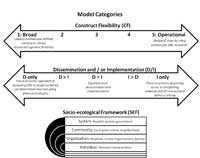Prevention Research Centers: PRC Researchers Develop the First Inventory of Dissemination and Implementation Models
October 2016
Researchers from the St. Louis University and Washington University in St. Louis PRC created an inventory of 61 Dissemination and Implementation (D&I) models and organized them according to three categories for use by D&I researchers.1 These models help to bridge the gap between research and practice by providing the structure that can be used to spread evidence-based approaches that prevent disease, promote health, and improve health services.2
The PRC researchers started their review by generating a brief list of commonly used D&I models and then employing a method called snowball sampling, which uses the reference lists from the original scientific articles to identify other models. Experts in the field of D&I research were also consulted during the process to identify additional models.
Once the researchers identified the models, they categorized them in the following ways:
- Construct Flexibility (CF): Models were scored on a scale of 1 to 5, where 1 was Broad and 5 was Operational:
- Broad was defined as containing more loosely defined constructs, thereby allowing greater flexibility to apply the model to a wide array of activities and contexts.
- Operational was defined as providing detailed, step-by-step actions clearly defined for a particular activity and context.
- Focus on Dissemination and Implementation Activities (D/I): Models were scored on a continuum of the following five categories: focus on dissemination only (D only), dissemination more than implementation (D < I), both activities equally (D = I), implementation more than dissemination (D < I), and implementation only (I only).
- Dissemination was defined as actively spreading evidence-based programs to specified audiences via determined channels through planned strategies.
- Implementation was defined as the process of using or integrating evidence-based programs within a setting.
- Level(s) of Socio-ecological Framework (SEF): Models were classified as focusing on a specific level or as cutting across several levels of the socio-ecological framework (outline shown below). Researchers also noted whether models addressed policy.
- System level, such as the hospital system or government level
- Community level, such as the local government or neighborhood level
- Organization level, such as the hospital, service organization, or factory level
- Individual level, or focusing on the personal characteristics of individuals

Variables used in the classification of D&I models:
Construct flexibility, dissemination and implementation, and socio-ecological framework3
Enlarge image
For example, the RE-AIM Framework was categorized in the following way:
- D = I — the framework has equal focus on dissemination and implementation.
- CF = 4 — the framework falls more on the operational side of construct flexibility.
- SEF = Community, Organization, and Individual — the framework focuses on the community, organization, and individual levels.
The RE-AIM Framework, along with four other models, was presented as a case study in the article. Each case study included additional information about the background of the model, how it has been applied, and any available information about the measures used with it. General tips on the usage, adaptation, and measurement of D&I models are also provided in the article.
The inventory has now been adapted in an interactive website (http://dissemination-implementation.org/) that allows researchers to match their research questions with the proper model. By using this inventory to identify and select an appropriate D&I model, future D&I research could build on previous findings and potentially increase the understanding and generalizability of the 61 models included in the inventory. For more information about the inventory and the 61 D&I models, please contact the lead author on the study, Rachel Tabak at the St. Louis PRC at rtabak@wustl.edu.
References
- Tabak RG, Khoong EC, Chambers DA, Brownson RC. Bridging research and practice: models for dissemination and implementation research. Am J Prev Med 2012;43(3):337-350. PMCID: PMC3592983 – In Process.
- Eccles MP, Mittman BS. Welcome to implementation science. Implement Sci 2006;1(1):1.
- Tabak RG, Khoong EC, Chambers DA, Brownson, RC. Models in dissemination and implementation research: useful tools in public health services and systems research. Frontiers in PHSSR. 2013;2(1):8.
- Page last reviewed: August 31, 2015
- Page last updated: November 10, 2016
- Content source:


 ShareCompartir
ShareCompartir